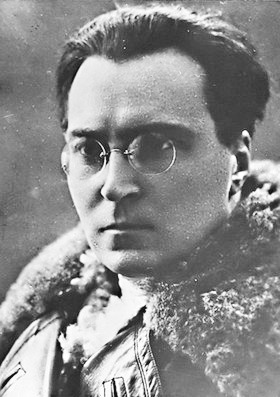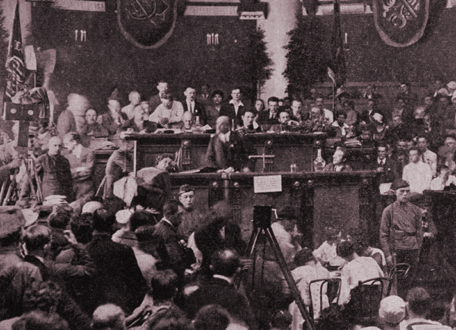Russian Revolution
Victor Serge: `dishonest authoritarian', `anti-worker anarchist' or revolutionary Bolshevik?

[The following exchanges were first published in the US socialist magazine Against the Current. They have been posted at Links International Journal of Socialist Renewal with permission. Susan Weissman is the author of Victor Serge: The Course is set on Hope and editor of The Ideas of Victor Serge and Victor Serge: Russia Twenty Years After. She is a member of the editorial boards of Against the Current and Critique. The first essay is adapted from a section of a paper she delivered at a July 2008 conference on Trotsky’s legacy and first appeared in Against the Current, issue 136, September-October 2008. Following that is a response from Ernie Haberkern and reply by Susan Weissman. Some of Victor Serge's writings are available at the Marxists Internet Archive and at Resistance Books.]
By Susan Weissman
Versailles vs Comintern: two visions of world peace

By Barry Healy
June 28, 2009, was the anniversary of the two bookends of World War I, in which it is estimated more than 15 million people died. On that date in 1914 Austrian Archduke Franz Ferdinand was assassinated in Sarajevo and, five years later, in 1919, 90 years ago this year, the Versailles Treaty was signed in Paris.
The first war in which the capacity of modern industry to deploy, feed, arm and dismember people was so hideously demonstrated, WWI was experienced by its victims as the "war to end all wars". Unfortunately, it proved not to be.
Out of the ashes of the conflict two competing visions of world peace arose: Versailles and the revolutionary and democratic alternative represented by the Communist International (Comintern) emanating from the 1917 Russian Revolution.
US President Woodrow Wilson swept into the treaty negotiations declaring: “The world must be made safe for democracy.” Over six months of intense horsetrading at Versailles a new imperialist order was hammered out, resulting in many of the conflicts that followed.
Pamphlet: Comrades in arms: Women in the Russian Revolution
To mark International Women's Day, Links International Journal of Socialist Renewal is publishing an excerpt from Resistance Books' Comrades in arms: Women in the Russian Revolution, by Kathy Fairfax, and making available the entire pamphlet to download in PDF format (see below).
By Kathy Fairfax
The popular image of the Russian Revolution is of a revolution made by men. Ask the person in the street to name a figure from the Russian Revolution and most could come up with Lenin, Stalin, maybe Trotsky. A few might have heard of Zinoviev, Kamenev or Bukharin. But how many would name Kollontai, Armand or Krupskaya? How many know of the women who helped make revolution in Russia? How many know about the thousands of female Bolsheviks who marched through the streets of Petrograd in 1917 or shouted revolutionary speeches to cheering crowds or wrote and distributed pamphlets calling for revolution? In fact, women revolutionaries inspired the working class the world over and inaugurated a new era in world history.
* * *
Free pamphlet: Revolutionaries and parliament: The Bolshevik experience
By Maurice Sibelle

By Chris Slee
Nationalism, revolution and war in the Caucasus
By Tony Iltis
August 27, 2008 -- Since the European Union-brokered ceasefire brought the shooting war between Georgia and Russia to an end on August 12, there has been a war of words between Russia and the West. One point of contention is the withdrawal of Russian troops from Georgia-proper (that is, Georgia excluding the de facto independent territories of Abkhazia and South Ossetia), in particular the towns of Gori, Zugdidi and Senaki and the port of Poti.
The war began with Georgia’s August 7 attack on the territory of South Ossetia. Russia responded with a military assault that first drove Georgian troops out of South Ossetia, then continued to advance within Georgia-proper.
Russia agreed to withdraw when it signed the ceasefire and has since indicated that it is doing so — but slowly, and not before systematically destroying Georgia’s military capacity.
A bigger difference, based on competing interpretations of what is and isn’t Georgian territory, is Russia’s stated intention to maintain a beefed-up peacekeeping presence in South Ossetia and Abkhazia.
¿La Unión Soviética, estado sin partido?
Reseña crítica de Alex Miller
El siglo soviético
por Moshe Lewin
Verso 2005
416 páginas
Los medios comerciales y las élites intelectuales capitalistas han promulgado un estereotipo sobre la Unión Soviética: una línea ideológica directa y sin interrupciones lleva del bolchevismo de la revolución de 1917 al totalitarismo del período stalinista (1920-1953), pasa por el período post-stalinista desde 1953 y termina en el colapso del régimen soviético en 1991. Normalmente, se esgrime el estereotipo contra el bolchevismo, y en realidad contra cualquier forma de marxismo revolucionario: se usa el estancamiento y la declinación post-stalinistas, así como las masacres y purgas del período stalinista, para elaborar una reducción al absurdo de las aspiraciones originales de la revolución de 1917.
The Soviet Union: a no-party state?
Review by Alex Miller
The Soviet
Century
By
Moshe Lewin
Verso
2005
416
pages
Our history: John Reed’s `Ten days that shook the world’
Ten Days That Shook The World
By
John Reed
Penguin
Books 351 pages
Paperback
Review by Alex Miller
Orwell’s Animal Farm and Nineteen Eighty-Four: Critiques of Stalinism `from the left’?
Review by Alex Miller
This essay is the result of a re-reading of George Orwell’s two most famous novels. Both Animal Farm and Nineteen Eighty-Four have acquired the status of textbooks, and are routinely used in schools to demonstrate to children the inherent dangers of social revolution. It is time for a reappraisal.
The ``Centenary Edition’’ of George Orwell’s Animal Farm contains a preface written by Orwell for the first edition (Secker and Warburg, 1945) but never published, together with a preface that he wrote specially for a translation for displaced Ukrainians living under British and US administration after World War II.
* * *